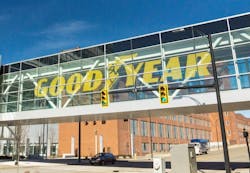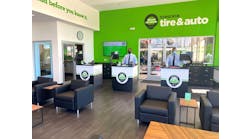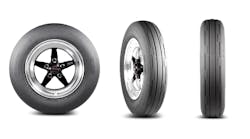Goodyear-Cooper Deal: CEOs Kramer, Hughes Discuss Impact on Dealers, Brands and More
Goodyear Tire & Rubber Co.’s acquisition of Cooper Tire & Rubber Co. “makes sense for both” companies, Rich Kramer, Goodyear’s chairman, CEO and president, said today during a conference call with Cooper President and CEO Brad Hughes. Kramer and Hughes covered a wide range of topics, from brand integration to what the firms’ tire dealers can expect to see, wholesale distribution opportunities and more.
On the integration of Cooper’s brands into Goodyear’s portfolio:
Kramer: “I would say, first and foremost, as we think about our businesses going forward, we’re going to do a lot more work on integration, but we’ll let the businesses continue to operate. As we look at the portfolios, I would tell you we still view our premium strategy with the Goodyear brand as key, as we look to the future. But we also know there’s a benefit to having a portfolio that really gives you a combined portfolio of multi-complementary brands to take care of customers in each of the various market segments and with the combination of the portfolios we have - think of Goodyear, think of Dunlop, think of Kelly and add to that the Cooper and Mastercraft brands - they all play in their right segments. We don’t view these as necessarily replacing each other, but rather being complementary in offering that enhanced value proposition to our customers and consumers.
“And when we think of the Cooper brand and the Mastercraft brand, particularly in light truck and SUV, Cooper has done really a wonderful job of shifting up to those premium products and being able to produce those, so that market position, I think, is one that as a combined company we’re going to take advantage of, rather than trying to do anything other than that.
“There's room for both the Goodyear premium brand and there’s absolutely room for some of the key brands that come with this combination.”
On what the companies' tire dealers can expect to see:
Kramer: “All of our customers and all of Cooper’s customers should have and will have available to them our ability to service them even better with an even wider array of products to serve them and all the customers who go into their stores. To be able to put our networks together, our products together, our services together, our OE pull - I think that service proposition actually gets better for them going forward. I would say (dealers) should feel good about it. And supply and service should be something that improves.``
Hughes: “I think when you look at the whole of it, in most cases, it’s going to offer more opportunities than risk. I think once they have a chance to understand the benefits of this and put it into the context of their businesses, they’ll realize that also. This is likely to provide more opportunities, as opposed to risk. You think about the resources that are available to both companies to develop tires and make sure we are bringing them to market more competitively - again, I think this offers opportunity.”
On opportunities to drive increase distribution efficiencies and how Goodyear plans to integrate Cooper into TireHub and its aligned, third party wholesale-distributors:
Kramer: “We’re on the front end of announcing this transaction and (are) excited about the opportunities that are ahead. We have more work to do on integration and I think those things will clarify themselves as we go forward.
“Clearly, there are opportunities to leverage TireHub and our network of third-party, aligned distributors. I do think it's premature to say with any specificity exactly how that will play out. We do have synergies in place for distribution and warehousing and we certainly expect to get some synergies through that. But exactly what that footpoint looks like, I think that’s something we’ll be talking about more in the future.”
On possible plans for domestic manufacturing plants and possible plant cuts (note: Goodyear has four plants in the U.S., two plants in Canada and one plant in Mexico, while Cooper has three plants in the U.S.):
Kramer: “The announcement we made today does not include any job losses or (plant) closures. As we look at our business, we always will continue to understand what’s the best way to move forward to make sure we are able to produce the tires our customers want. And that will be some of the work we look at into the future. We are looking at how we can utilize this combined footprint the best way - and the best way to make sure we’re getting the highest level of productivity and the best way to make sure we are able to supply premium tires.”
On areas that will will benefit most from cost-savings (note: Goodyear says $165 million in savings will be realized within two years of the deal’s closing, which is scheduled to take place during the second half of 2021):
Kramer: “We said about $165 million (will be) realized over the two-year period and we’re seeing that in areas like SG&A (selling, general and administrative expenses), research and development and in distribution - warehousing and procurement. Those are some areas I think you'd see those synergies coming out of. We also have significant tax benefits coming from this as well, at about $450 million."
Regarding manufacturing synergies, “we did not build any of those in at the moment, but our intention as we work through integration is to understand better how we can best utilize and optimize the capacity of the two combined footprints. We believe there will be opportunities to utilize our combined footprint in a more beneficial way. As we get that work done, you will hear more about that going forward.”
On how the deal happened and why Goodyear and Cooper determined it was a good move for both companies:
Kramer: “This was a question of both of us thinking of how we can increase our competitiveness in the future, looking at the global tire industry. It made it attractive for Goodyear and I think the market will recognize that, as well. That shift to premium products, the implementation of a lot of successful manufacturing initiatives - this combination made sense from our perspective. And again, we are really confident this adds compelling value creation benefits. It improves our balance sheet and it certainly improves our ability to invest in the future, moving forward.”
Hughes: “When Rich originally approached us, we weren't looking to sell the company. We were feeling quite good about the strategy and direction of the company, but ultimately, we needed to represent our shareholders and they presented first of all, a very compelling offer for the company, and secondly, very compelling strategic logic… that positions the combined entities to being successful going forward. We saw the logic of that and we saw what we could deliver to our shareholders. We believe it’s the right move.”
On additional revenue growth opportunities for Goodyear:
Kramer: “As we look forward, you will hear more about how we go to market once we get the transaction approved. As you look at the two separate companies, the Goodyear brand was gaining share up until we hit the COVID-19 period. And you know, we lost some share because of Walmart's closure of its auto service centers. And I think Cooper had been on that path, as well. I think as we look at the competitive nature of the tire industry out there and we look at the momentum we have based on technology, based on the product portfolio we have, based on the distribution points we have and then how that becomes enhanced as a combined company, I think we were both in the mode of building the mindset of continuing our growth. And I think the combination of the two of us allows us to stay on that path.”
On the impact on future mobility efforts and tires for electric vehicles:
Kramer: “We have been thinking more and more about the sustainability of our products, going forward. Our soybean oil replacing petrochemicals in tires has been a big hit. We believe that the percentage of sustainable products in tires is only going to increase and we are on the path to do that, doubling where we are today. I think Cooper really saw that same path as we looked at all the influences around us.
“On the new mobility and EV side, we are 100% committed to doing that with the OE fitments we are winning nowadays. As much as 50% or more of the new OE fitments we win are for EVs. We view that new mobility ecosystem as something that we’re going to lead in, going forward, and we view the scale we get from this combination is allowing us to have the ability and resources to invest in that future.”
Hughes: “The opportunity to bring together two portfolios of technologies that are being developed in the two organizations for some tires right now and looking at the future of the tire and automotive industry - bringing those portfolios together, looking at where there is overlap, opportunities to prioritize and put certain technologies together to advance the outcomes faster - that’s the exciting part. And now you have more scale for which you can make those types of investments and put them into applications in real tires on the road. I think bringing that together is just going to help us bring it to the market faster.”
On how the opportunity to boost Goodyear’s exposure in China played into the transaction (note: Kramer said that the Cooper acquisition “nearly doubles our presence in China.”):
Kramer: “I think it’s very important. It essentially doubles our size there and gives us capacity and better relationships with the OEMs - particularly the local automakers - so this is a key area. It’s clearly a benefit for us going forward. We (also) are focusing on our ability as a U.S. company to be a strong leader in the global industry. I think the combination of Goodyear and Cooper’s attributes probably made that the most attractive part of this, in solidifying our position in the U.S.”
On international manufacturing:
Kramer: “For us, expanding onto a factory is something that gives higher returns on investment in capital faster… rather than having to do it from the bottom up. As we look at that and we see how to best utilize the capacity of the combined entities, I think greenfield opportunities at low-cost factories are something we’d look at and are interesting to us, moving forward.”
“We are extremely pleased and excited about the transaction and the combination of Goodyear and Cooper, going forward,” said Kramer. “The transaction has clear and compelling industrial logic.
“It strengthens our position in the global tire industry by giving us expanded leadership in the U.S. and it significantly increases our strength in other North American markets and it nearly doubles our presence in China.
“Secondly it gives us an expanded ability to service our customers and consumers with a combined portfolio of complementary brands across the value spectrum.
“In addition, it gives us enhanced depth in what we view as the highly profitable light truck and SUV segments. The light truck/SUV (tire) business has been growing and our portfolio - along with Cooper’s portfolio - certainty is well-positioned to be a leader in that highly profitable segment.
“It also gives us a strong financial foundation,” said Kramer. “It gives us an improved balance sheet and an opportunity to grow. Even though we took on debt for this transaction, our credit metrics are improved for doing this.
“And it also gives us an opportunity to optimize our combined manufacturing operations. We fundamentally believe the two of us, together, can better manage and get to increased productivity.
“In addition, Cooper has some locations in very low-cost sources that offer greenfield expansions, as well, so we know we have opportunities to optimize our combined manufacturing operations.
“And as we look to the future, it gives us increased scale to continue to invest in new mobility and fleet services as we move to that new mobility ecosystem that we know maybe isn’t even on the horizon anymore, but is right in front of us and is gaining steam.
“We know that integration is key to making sure we get the value from the deal we have,” said Kramer.
“We also are excited about this transaction,” said Hughes. “We believe it delivers strong and immediate returns to our shareholders and offers an opportunity to participate in the future value creation of the combined companies.
“We feel it recognizes the great progress we have made as a company - transforming into a consumer-facing company with a strong manufacturing footprint, which was made possible by the great work of the Cooper team around the globe.
“We also believe that bringing the two companies together will make a stronger, more competitive force in the industry.”



